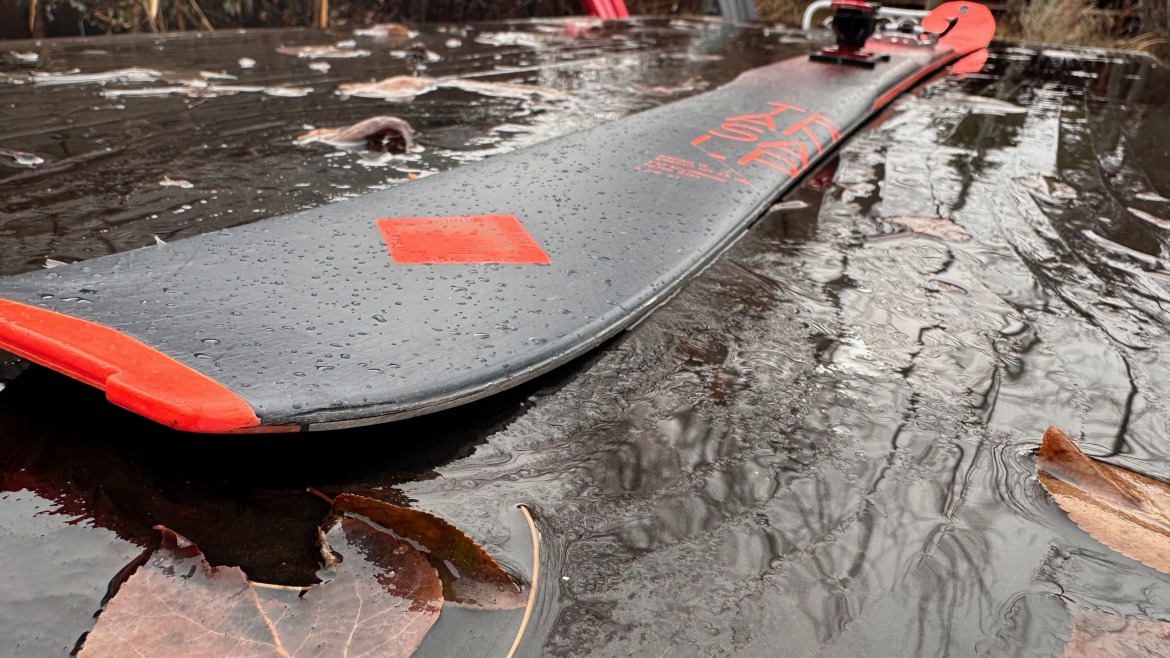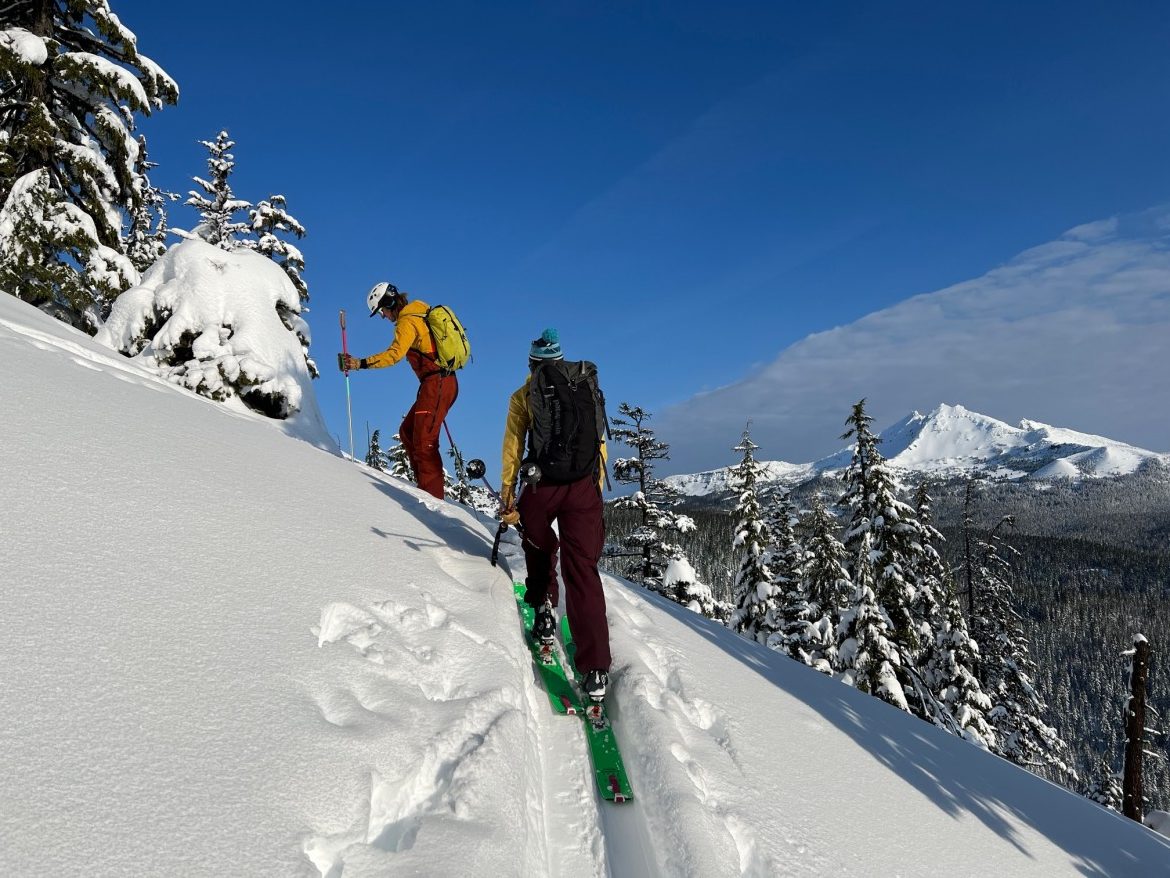
Fischer’s Transalp 86 Carbon provides sufficient surface area underfoot and modestly lightweight build to make skinning and turning sweet fun.
In a somewhat crowded marketplace for lighter and skinnier skis, the Fischer Transalp 86 Carbon stands out, not in a flashy way, as a can-do stable ski. Spring corn and firm steeps anybody?
Following a high and dry winter, spring in Central Oregon delivered the deep POW goodness. After greedily gobbling up all that was possible, we sat out a bit of a delay to the spring Volcano bagging season as unseasonal rains turned our snowpack into an isothermic nightmare. The weather finally broke, giving us those classic cold clear nights and warm sunny days, producing corn skiing dreams. This was the opportunity to test the Fischer Transalp 86 Carbon, a ski I have been anticipating to be a good companion for spring and early summer of Cascade Volcano summit hunting.

The most recent 2022-2023 Transalp 86 Carbon: just more red and less black on the topsheet compared to the year younger model tested.
The Basic Specs
Length Tested: 183cm
Weight (verified, 183cm): 1283g
Dimensions: 124, 87, 108
Radius: 19m
Profile: Flat tail, camber underfoot, moderate tip rise
Price: MSRP $749.99
Digging into the Stats
The Transalp 86 comes in six (!) lengths, from a stubby 148 up to the longest option at 183, with stops at 155, 162, 169, and 176 along the way. This spectrum ensures the most discerning of length snobs’ needs can be met. Since I am 6’5″ and 185lbs, I went for the big daddies, the 186cm.
Claimed weight is 1180g per ski in the 176cm length, with my longer examples weighing in at a verified 1283g a ski.
The Transalp 86 construction consists of “specifically placed carbon fiber and a milled Air Tec Paulownia wood core with titanal binding reinforcement,” which is claimed to “keep the weight low while providing torsional stiffness and stability.” The ski has “sandwich sidewall construction” with ABS sidewalls for “balanced flex and perfect rebound.” The ski is said to be “ready for any mountain and any terrain.”
“Any” terrain is a lot of terrain. A ski coming in at 86mm has a sweet spot, and it is not in every type of terrain or condition. I suspected these skis would shine in the high alpine on beautiful spring days with tons of vert. (Read on if this self-fulfilling prophecy came to be.) I suspected the construction had enough beef to handle icy steeps and the (occasional) mistimed corn cycles.
This is a fairly traditional ski with conservative underfoot camber, flat tails, and a hint of tip rocker.
The Transalp series also has a 90mm underfoot option. Still, I chose the smaller 86mm (the 183 I tested is actually 87 underfoot) ski as I want to use these for the really big days, and with promised “excellent downhill performance,” I was hoping they are an able companion on the big days.
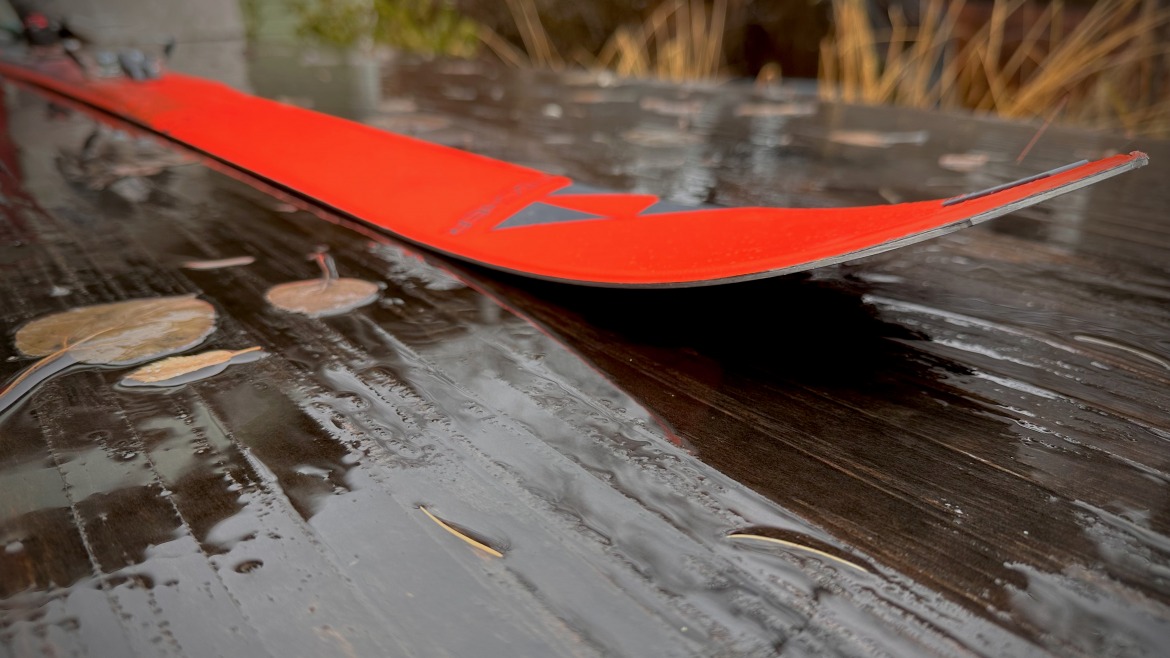
The Fischer Transalp 86 Carbon’s tip has some modest rocker to help float over minimal amounts of chop. But the shape and camber make this ski shine in corn and firm snow conditions.
I mounted the skis with Plum 150 bindings with an adjustment plate (essentially a Plum 170), so I can ski them with my race boots (Dynafit PDG) and my touring boots (Fischer Transalp Pro). I wanted to know if the lighter race boots have enough oomph to drive these fairly long 86mm underfoot skis because that sure would be nice for the long approaches. If not, I knew the bigger boots would handle them just fine.
The total weight for the mounted package sans skins is 1501g. Full disclosure, this is by far my lightest ski setup currently in my quiver by a good 400 grams. I have tried race skis and lighter skinny stuff in the past, and I tend to use them once, then go back to my bigger skis because the skiing quality (or my perceived lack of it) isn’t worth the weight savings for me. My fingers were crossed that l I find a more substantial skiing experience on these Fischers. I don’t like doing all that work uphill to tiptoe back down the mountain.
An interesting skin tip attachment system on the skis consists of a hole placed in the tip of the ski and a specific skin tip clip that slots into them. Fischer makes a precut matching skin for this ski with the special tip, but I am using a Contour Hybrid skin with the special tip clips installed. (You can find the tip clips for sale separately.)
Hitting the Snow
When the skis arrived, I was impressed with their curb appeal. Snazzy graphics, obvious attention to detail with easy-to-use mounting marks, an excellent tune, and low weight had me excited to get them on snow.
Once mounted and with the contour skins attached with the special tip clip, the total package weight was 1669g per foot: impressive.
For my first outing on the skis, I headed out to scout the course for an underground ski race I am associated with near Mt. Bachelor. The course represented the type of skiing I intend to do with these skis: a combination of big vert, long, low-angle sections, and steep descents with variable snow conditions.
Immediately out of the parking lot, I was impressed with the ease of touring. Shedding 400g per foot from my usual setup was striking. After about 40 minutes of skinning, we reached our first transition and looked out across our intended route. Switching to descent mode was so normal I forgot about the unusual ski tip system until our next transition. Although very functional, the tip clip system has little to no discernable advantage over a traditional tip loop that I can find. It could save a few grams.
The first few turns into consequential terrain are always nerve-wracking, especially on unknown gear. After a few careful turns sussing the skis out, I started to open them up and quickly gained confidence in their edge hold, stability, and forgivingness. Previous forays on light skis gave me little to revel in on the descents, always feeling way too stiff and simultaneously extremely underpowered.
The Fischers, on the other hand, were quite forgiving and easygoing. After very little time, I was skiing any way I liked on them, still within reason for this style of ski, but pretty much uninhibited in comparison.
Over the course of our five-hour traverse, I warmed up to the whole new package. At the start of the day, we were skiing pretty nice preserved pow on the north aspects, with some firm but cold windboard mixed in. As the day progressed, we got into a few pretty scoured icy chutes, breakable crust, and finally, some of my favorite, the fabled hot pow.
Through it all, the Transalp 86 Carbon remained intuitive and easy to ski. After so many disappointing first dates with other light skinny skis, it was a pleasant surprise to find a light ski that kept my attention when things got more intimate and demanding. I could ski the Transalp 86 Carbon like I wanted to, rather than the ski dictating my turns.
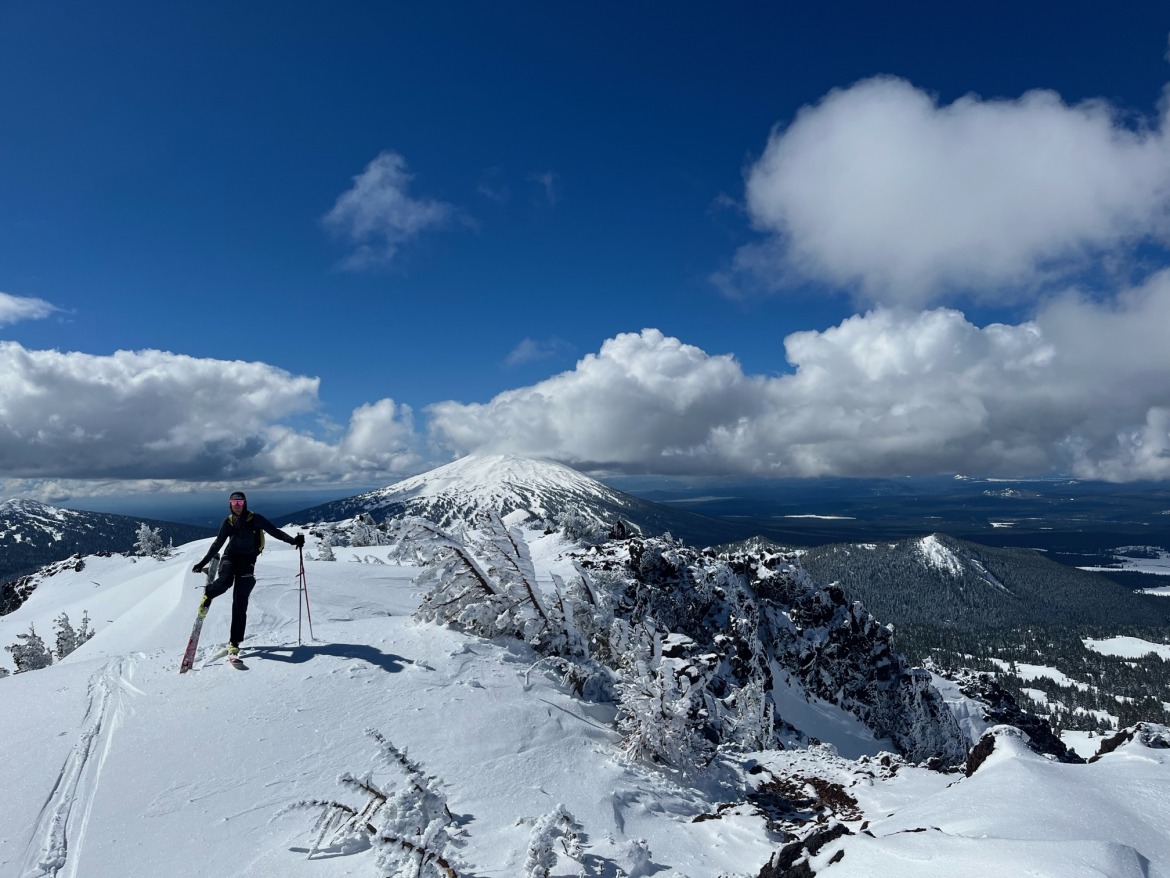
I’m a tall lad. But with these light planks and my limber joints, skinning and ripping skins is like springtime sunshine: bliss.
Deep Spring and Closing it Out
Over the next two months, our spring ski season began in earnest, and the Fischers became my go-to for long days chasing volcano summits in the Oregon Cascades. After repeated thrashings dragging the skis through thickets of brush, up ridgelines, and down creamy (or sometimes heinous) corn, I am left satisfied and impressed. I only occasionally wanted more ski under my feet on the descents, and their lightweight was always a welcome presence on foot or pack during the extended approaches and exits we tend to find in the Cascades. Finally, I have found a ski that performs on the DH as I’d hoped it could but gives the legs and shoulders the ethereal feel of a light, mountaineering ski.
I’d also like to add an honorable mention to the Contour Hybrid skins. They were an old pair of white-colored, Atomic branded skins I had stashed in the back of a drawer from some other long-sold pair of skis; they just so happened to be compatible with the proprietary Fischer tip clips. I cut them to size, installed the clips, wiped the “sticky” side with some Contour cleaning wipes, and was in business.
What stood out the most to me was the incredible glide. I’m not sure if I just somehow found a magic pair of skins, but I was dropping my elite-level nordic ski partner on the flat-skinning transverse sections, which I have no business doing with my mediocre at best classic technique. She was on those fancy pink skins for reference, which I often also use, but some combination of closet skin aging technique, or who knows what, had me gliding off ahead of her, much to her chagrin. The grip was plentiful on the ups, as was adhesion to the skis. If only the backing were a touch thinner to increase packability, these skins would be my all-time favorite.
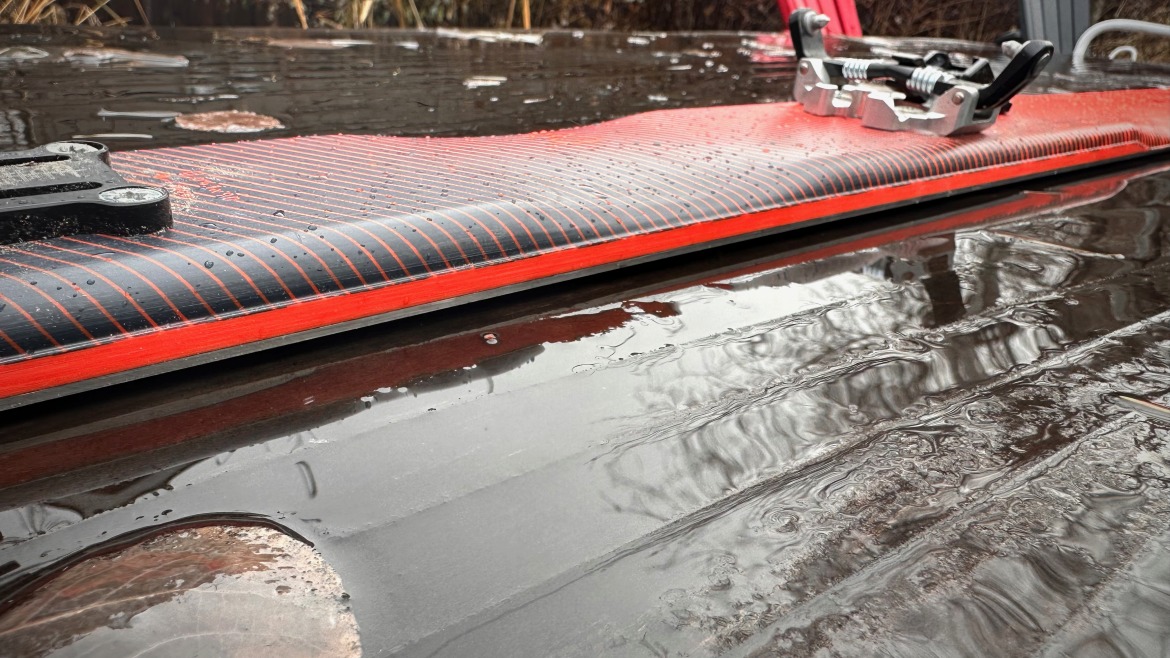
For several years, the mid-section of the Transalp series has incorporated what they call an Aeroshape to add torsional rigidity. Additionally, the ski features an ABS sidewall underfoot to dampen the ride a bit and add some durability.
Back to the Ski
I skied the Transalp 86 Carbon with both the PDG boot and the Transalp Pro boot. While the PDG can adequately drive the ski, I prefer the more dynamic, progressive flex of the Transalp Pro, even with its fairly substantial weight penalty for me and my XL frame. High ROM is good on light sticks intended for long traverses, and the Transalp Pro worked wonderfully.
So, the final question is, did the Transalp 86 Carbon break my curse of disappointment in light, skinny skis? I can unequivocally say it has. And although I’m a downcountry disciple, I’m allowed to deviate a bit.
I was surprised to find a diminutive ski to compromise so little in downhill performance. Obviously, I’m not going to be inclined to jump off as much stuff or irresponsibly straight line through nasty snow on a lightweight setup like this, especially with race bindings. However, I finally found a ski that gives me that scrumptious feel of lightness on my feet and still skis wonderfully composed and with an ease I am still surprised with every time I rip skins and slide into that steep fall line of corny bliss.
Shop for the Fischer Transalp 86 Carbon.
Barry Wicks, also known as @wicknasty, demphasizes the nasty and embraces the kindness. He lives in Bend, Oregon where in a parallel universe he covets all things cycling. And although he might not admit it, some say he was once quite speedy on a bike. Also, amongst WildSnow writers, he has the best hair.

